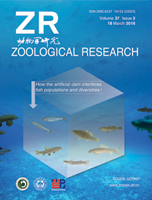
|
Zoological Research
Kunming Institute of Zoology, Chinese Academy of Sciences
ISSN: 2095-8137
Vol. 41, No. 3, 2020, pp. 247-257
|
 Bioline Code: zr20029
Bioline Code: zr20029
Full paper language: English
Document type: Research Article
Document available free of charge
|
|
|
Zoological Research, Vol. 41, No. 3, 2020, pp. 247-257
| en |
Decoding the evolution and transmissions of the novel pneumonia coronavirus (SARS-CoV-2 / HCoV-19) using whole genomic data
Yu, Wen-Bin; Tang, Guang-Da; Zhang, Li & Corlett, Richard T.
Abstract
The outbreak of COVID-19 started in mid-December 2019 in Wuhan, China. Up to 29 February 2020, SARS-CoV-2 (HCoV-19 / 2019-nCoV) had infected more than 85 000 people in the world. In this study, we used 93 complete genomes of SARS-CoV-2 from the GISAID EpiFluTM database to investigate the evolution and human-to-human transmissions of SARS-CoV-2 in the first two months of the outbreak. We constructed haplotypes of the SARS-CoV-2 genomes, performed phylogenomic analyses and estimated the potential population size changes of the virus. The date of population expansion was calculated based on the expansion parameter tau (τ) using the formula
t=τ/2u. A total of 120 substitution sites with 119 codons, including 79 non-synonymous and 40 synonymous substitutions, were found in eight coding-regions in the SARS-CoV-2 genomes. Forty non-synonymous substitutions are potentially associated with virus adaptation. No combinations were detected. The 58 haplotypes (31 found in samples from China and 31 from outside China) were identified in 93 viral genomes under study and could be classified into five groups. By applying the reported bat coronavirus genome (bat-RaTG13-CoV) as the outgroup, we found that haplotypes H13 and H38 might be considered as ancestral haplotypes, and later H1 was derived from the intermediate haplotype H3. The population size of the SARS-CoV-2 was estimated to have undergone a recent expansion on 06 January 2020, and an early expansion on 08 December 2019. Furthermore, phyloepidemiologic approaches have recovered specific directions of human-to-human transmissions and the potential sources for international infected cases.
Keywords
COVID-19; HCoV-19; SARS-CoV-2; Novel pneumonia outbreak; Human-to-human transmission; Phyloepidemiology
|
| |
© Copyright 2020 - Editorial Office of Zoological Research, Kunming Institute of Zoology, Chinese Academy of Sciences
Alternative site location: http://www.zoores.ac.cn/
|
|
